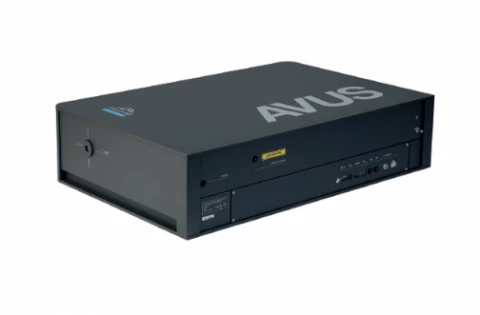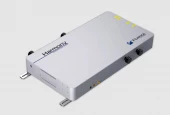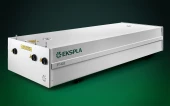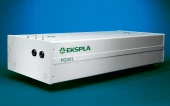Description
The AVUS Optical Parametric Amplifier (OPA) represents the pinnacle of modern laser technology, offering a seamless blend of innovation and reliability. Tailored for use with 1 µm femtosecond lasers, this advanced OPA is engineered to deliver high-energy pulses with exceptional precision. Capable of handling up to 50 W of pump power, the AVUS OPA is a testament to cutting-edge engineering, ensuring consistent performance across a wide range of applications.
Designed with user convenience in mind, the AVUS OPA features a fully automated, computer-controlled system that simplifies operation and enhances usability. Its air-cooled, monolithic case design ensures long-term thermal stability, even under maximum pump power conditions. This robust construction not only prolongs the lifespan of the device but also safeguards its sensitive internal components with a sealed inner case.
The AVUS OPA stands out with its remarkable tunability, covering an extensive wavelength range from 210 nm to 11 µm, encompassing UV, VIS, and IR spectrums. The integrated tuning and automatic wavelength separation capabilities ensure that the beam maintains a consistent position and direction across all wavelengths, eliminating the need for external beam routing or adjustments. This feature, combined with 24/7 integrated performance monitoring, makes the AVUS OPA a reliable choice for continuous operation.
With its TCP/IP remote control and standardized command set, the AVUS OPA offers ease of programming and integration into existing systems. The optional bypass for SHG and pump beams adds further versatility, catering to a wide array of experimental setups. The AVUS Optical Parametric Amplifier is not just a piece of equipment; it is a comprehensive solution for researchers and professionals seeking precision, reliability, and ease of use in their optical experiments.
APE AVUS Optical Parametric Amplifier
Specifications
| Widest Tuning Range: | 200 – 10000 nm |
|---|---|
| Signal Polarization: | Vertical, Horizontal |
| Core Tuning Range: | 630 – 2600 nm |
| Peak Efficiency (S+I): | 12 % |
| Idler Polarization: | Vertical, Horizontal |
Features
- High Power fs OPA: The AVUS Optical Parametric Amplifier is designed for high-energy pulse generation, ideal for 1 µm femtosecond lasers with up to 50 W pump power.
- Wide Tunability: Offers a broad wavelength range from 210 nm to 11 µm, covering UV, VIS, and IR spectra.
- Automated and User-Friendly: Fully automated and computer-controlled, AVUS eliminates the need for external beam routing or separation, maintaining consistent beam position and direction across all wavelengths.
- Air-Cooled, Monolithic Design: Ensures long-term thermal stability even at maximum pump power, with a maintenance-free, air-cooled system.
- Long-Life Operation: Features a sealed inner case to protect sensitive components, ensuring durability and reliability.
- Remote Control Capabilities: Equipped with TCP/IP remote control using a standardized command set for straightforward programming and integration.
- Integrated Performance Monitoring: Continuous 24/7 monitoring of both the laser system and AVUS for optimal performance.
- Optional Bypass: Available for SHG beam (green) and pump beam, providing flexibility in experimental setups.
- Application Versatility: Suitable for a variety of applications including nonlinear microscopy, femtosecond pump-probe spectroscopy, and terahertz emission studies.
- Output Spectra: Provides typical output spectra and pulse widths, with transform limits for precise applications.
Applications
- Nonlinear Microscopy: Utilize the AVUS OPA for advanced imaging techniques that require nonlinear optical processes.
- Femtosecond Pump Probe Spectroscopy: Ideal for experiments requiring precise timing and control over ultrafast events.
- Time-Resolved Spectroscopy and Photoluminescence (TR3, TRPES, TRPL): Analyze dynamic processes in materials and biological samples.
- Photoelectron-Photoion Coincidence Spectrometry (PEPICO): Perform detailed studies of molecular fragmentation and ionization processes.
- Coherent Anti-Stokes Raman Spectroscopy (CARS): Achieve high-resolution vibrational imaging and chemical analysis.
- Two-Dimensional Infrared Spectroscopy (2D-IR): Investigate molecular dynamics and interactions with enhanced spectral resolution.
- Terahertz Emission Studies: Explore the properties of materials and devices in the terahertz frequency range.
Frequently Asked Questions
What is the AVUS Optical Parametric Amplifier used for?
What is the maximum pumping power of the AVUS Optical Parametric Amplifier?
What is the wavelength range that the AVUS Optical Parametric Amplifier covers?
Is the AVUS Optical Parametric Amplifier user-friendly?
What are some of the features of the AVUS Optical Parametric Amplifier?
Similar Products
Your inquiry has been received.
Create an account by adding a password
Why create an account?
- Auto-complete inquiry forms
- View and manage all your past messages
- Save products to your favorites
- Close your account anytime — no hassle



